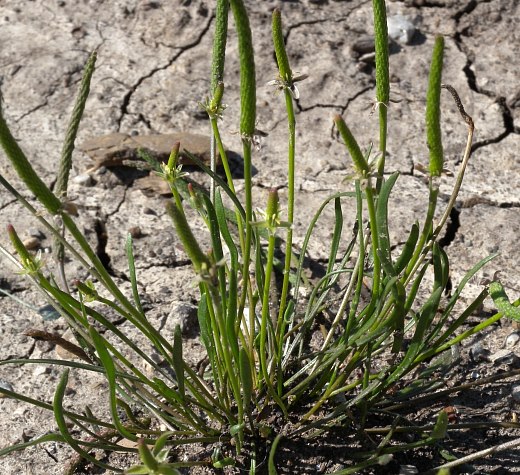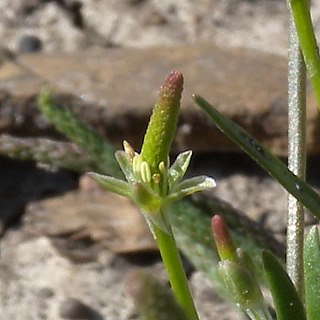Description: This little plant is a winter or spring annual, producing a rosette of basal leaves and one or more flowering stalks. Individual basal leaves are 2-4" long and about 5 mm. across; they are medium green, linear in shape, glabrous, and smooth along their margins. The tips of the basal leaves are blunt. Each flowering stalk is 2-6" long and unbranched; it is usually naked, except for a single flower at its apex. Each stalk is medium green, glabrous, and terete.

Each flower
consists of 5 petals, 5 sepals, 5-10 stamens, and an elongated ovary
that becomes 1–2½" long at maturity. The sepals are located at the very
bottom of the flower; individual sepals are about 5 mm. long, whitish
green, widely spreading, and lanceolate-oblong in shape. In addition to
its upper portion, each sepal has a spur-like extension that is
narrowly triangular in shape and extends downward. Individual petals
are about 5 mm. long, yellowish green, linear in shape, and bent
downward and outward toward the middle. There is a nectary located at
either the apex of each petal or its base. The cylindrical ovary
consists of numerous pistils; it is usually green, although sometimes
red toward its apex in sunny situations. The blooming period occurs
from mid-spring to early summer and lasts about 1-2 months. The flowers
are at least partially self-fertile. At maturity, each pistil of the
ovary is replaced by a single achene. The small achenes are bluntly
rectangular and somewhat flattened; they have short beaks. The root
system consists of a tuft of fibrous roots from a short crown. This
plant reproduces by reseeding itself.
Cultivation:
Mousetail adapts to full or partial sun, moist to slightly dry
conditions, and soil containing loam, sandy loam, gravelly loam, or
clay-loam. Most growth and development occurs during the cool moist
weather of spring.

Range & Habitat:
Mousetail is found occasionally in the southern half of Illinois, while
in the northern half of the state it is rare or absent (see Distribution
Map). It is native to North America, Eurasia, and northern
Africa. Habitats include barren areas along woodlands, eroded areas
along streams, cropland and pastures, damp areas bordering mud puddles,
gardens and outdoor nurseries, and sunny waste areas. Generally, this
plant is found in disturbed areas where there is scant ground
vegetation and exposed soil.
Faunal Associations:
Very little is known about floral-faunal relationships for this obscure
little plant. The flowers are pollinated, at least in part, by small
insects; both pollen and minute amounts of nectar are available as
floral rewards to such visitors. Robertson (1929) observed the Halictid
bee, Lasioglossum zephyrus, collecting pollen from
the flowers, while Müller (1873/1883) observed the Syrphid fly, Melanostoma
melinum, and several other small flies and parasitoid wasps
visiting the flowers. However, such floral visitors are relatively
uncommon.
Photographic Location:
An area with exposed soil near the county courthouse in Urbana,
Illinois.
Comments:
This odd-looking little plant is easily overlooked and often omitted
from many wildflower and weed guides. It is now time to bring this
plant to the attention of members of the public. Mousetail
superficially resembles a plantain (Plantago sp.)
with narrow leaves,
but it belongs to a very different family of plants (Ranunculaceae).
Other species of plants in this family are quite distinct in appearance
because of their showier petals, wider leaves, and/or shorter ovaries.
As a result, Mousetail is easy to identify once one becomes familiar
with it. Several subspecies have been described, but only the typical
subspecies, ssp. minimus, has been found in
Illinois.